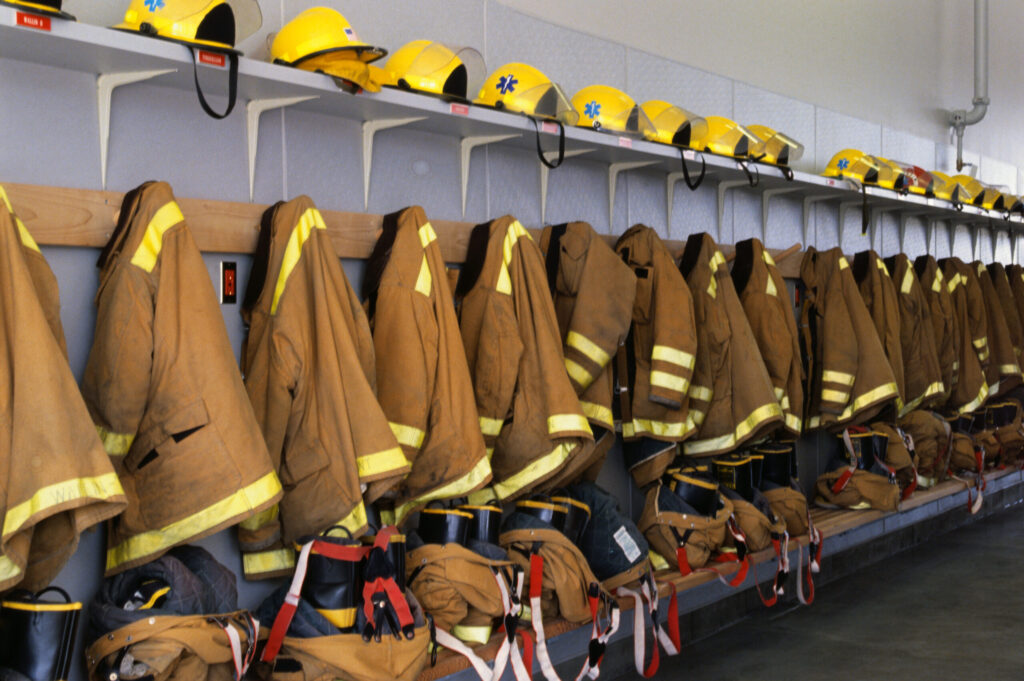A row of firefighters’ helmets, coats, and boots in suspendered pants hang at the ready at a fire station. (Getty Images)
Firefighting can be a very rewarding career, but it entails numerous risks, from smoke inhalation to serious injuries from collapsing buildings.
Still, a more obscure health threat to these brave people is toxic exposure, as firefighters come in contact with plenty of harmful substances on the job, including formaldehyde, hydrogen cyanide, benzene, polychlorinated biphenyls, asbestos, carbon monoxide, but also perfluoroalkyl and polyfluoroalkyl substances. These substances are often referred to as PFAS or “forever chemicals” due to their ability to persist in the environment and the body for a long time.
Exposure to PFAS is responsible for many awful health issues, such as kidney, prostate, and testicular cancer. While firefighters are exposed to “forever chemicals” from their use of aqueous film-forming foam, or AFFF, a toxic fire suppressant that sometimes contains 98% PFAS, these dangerous substances are also lurking in their very turnout gear.
There are 441 fire departments registered with the National Fire Department Registry in South Carolina. Manning these departments are 52.5% volunteers and 9.8% career firefighters.
The Columbia Fire Department is the largest in the state. It achieved its Class 1 rating, which places it in the top 1% for fire suppression services. With 500 personnel covering 32 fire stations, it serves over 500,000 citizens in the city and throughout Richland County. Firefighters respond to 35,000 to 40,000 emergency disasters yearly.
Meanwhile, implementing fire protection programs and responses has intensified due to the increasing global temperature, which has brought extended periods and frequency of wildfires.
Wildfires in South Carolina average 3,000 annually, one of the highest rates in the country. The average area burned is 18,000 acres per year. The largest occurred in April 1976, affecting 30,000 acres in Horry County. These fire incidents have increased the use of turnout gear, which protects firefighters from harsh environments.
PFAS are found in all three layers of turnout gear, with the highest concentrations in the outer second and third layers, which can be up to 400 times higher than the inner layer. Currently, available turnout gear still contains a dangerous variant of PFAS in the middle layer, specifically ePTFE.
Gear manufacturers use PFAS for their water- and oil-repellent properties, which makes them the only viable option that meets the National Fire Protection Association’s stringent performance criteria.
However, this might change in the future. On July 20, 2023, Congresswoman Debbie Dingell, a Michigan Democrat, introduced the PFAS Alternatives Act, a bill promoting PFAS-free turnout gear. The bipartisan coalition of co-sponsors was led by Brian Fitzpatrick, a Pennsylvania Republican, co-chairman of the PFAS Task Force.
The number of co-sponsors has grown from seven when it was introduced to 94 (69 Democrats and 25 Republicans), showing good bipartisan support for potential action in the lame-duck session or reintroduction next year.
Signing it into law wouldn’t carry immediate effects, but it will bring us closer to reducing PFAS exposure for firefighters and improving their safety over time.
The purpose of the bill and allocation of grants
The PFAS Alternatives Act would authorize $25 million every year for each fiscal year from 2024 to 2028, aimed solely at research, development, and testing, and an additional $2 million would be allocated for training.
The funds will be distributed across the country, likely through competitive grants, to institutions and organizations that are involved in research and development.
The grant recipients will be required to make partnerships with industry stakeholders, including labor unions such as the International Association of Fire Fighters (IAFF) and local unions, and with firefighter organizations such as the National Firefighters Foundation (NFFF) and National Association of State Fire Marshals (NASFM).
Impact on local fire departments
While the bill includes significant funding for research, it does not mandate financial assistance for fire departments to purchase the new equipment, nor does it guarantee that they would immediately receive it.
The development and release to the market will take some time, and without special procurement funding, fire departments may still face financial challenges in replacing their gear.
The bill encourages innovation and initiatives for best practices to reduce firefighter exposure. It does not suggest an outright ban or a clear timeline for gradual phaseout. The phased removal will likely happen once alternatives are commercially available.
But we’ll have to see if requirements concerning immediate replacement will be imposed in the future.
Certainly, the measures inside this act are oriented toward creating a hopeful and healthier future for firefighters.
However, the bill’s actual impact on firefighter exposure to PFAS depends entirely on how fast innovation happens and on future funding prospects for fire departments to procure the replacements.
Until then, firefighters will continue to use their current gear and endure the toxic consequences.

